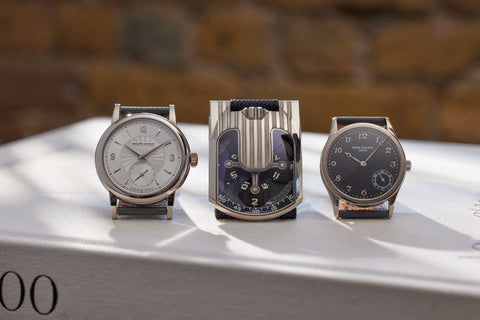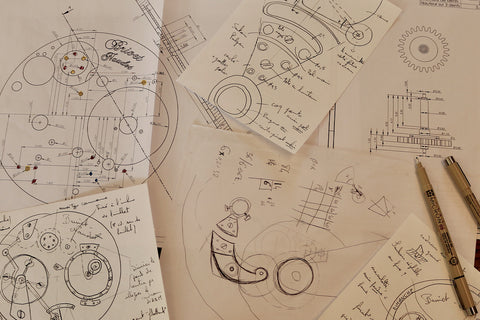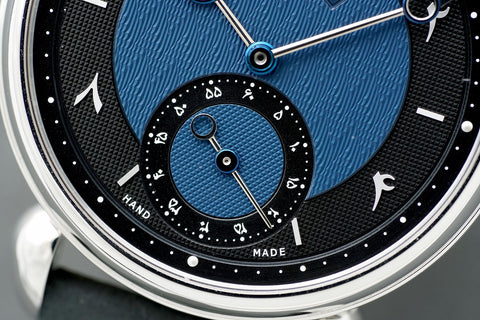Paul Gerber is perhaps best known for his work on the MIH watch as well as on the “Superbia Humanitatis” with Franck Muller, named the most complicated wristwatch ever created in 2005. One of just 20 pieces, this Retro Twin further demonstrates his wide-ranging interests, combining two platinum rotors in the movement, and paying careful attention to both the aesthetics of the dial and overall profile of the watch. Such an array of artisanal watchmaking elements is difficult to find at Paul Gerber's price level.
Worth Reading
Paul Gerber’s rich career is an example of going one's own way. Unafraid to pursue unusual concepts and with a clear focus on innovation, his work is technical, characterful and not always given the recognition it deserves from the mainstream. Born in Bern, Switzerland, Gerber would move to Zurich after achieving his watchmaking diploma to open his own restoration workshop. One of the first independent watchmakers, he established his independent brand in 1976, to create original pieces and explore the limits of his ideas. He has won several awards, including the 2007 Gaïa Prize. Today, he is moving into semi-retirement, leaving behind a significant body of work. Gerber is not just a watchmaker, he is also an educator who works closely with younger watchmakers as a mentor, and is especially known for his knowledge and generosity.
Gerber’s work covers a broad spectrum, demonstrating his wide-ranging interests. Some notable examples include the MIH watch made for the Musée Internationale de l’Horlogerie, a minimalist piece featuring a simple annual calendar complication; to the “Superbia Humanitatis”, featured in the 2005 Guinness World Book of Records as the most complicated wristwatch ever created, which Gerber worked on with Franck Muller, who had added more complications to an already complicated Louis-Elysee Piguet movement.
Introduced in 2001, only 20 examples of the the Retro Twin ref. 158 were made, boasting a power reserve complication at 12 o'clock. The watch continues Gerber’s vision with a double-rotor system, the Paul Gerber 15, which is based on an extensively modified Peseux 7001 ebauche, which allows the watch to function as an automatic piece. This system is entirely unique, and Gerber holds a patent for it. The two platinum rotors are part of a modular system, with its own plate and bridge. A central coupling wheel is used to ensure that the rotors do not collide, and in turn, a jig secures the rotors to their wheels. The bridges themselves have a rather whimsical shape and are decorated with wave-style engravings. As a whole, the movement is decorated to an excellent standards, a delicate Côtes de Genève pattern and perlage.
The dial falls somewhere between classical and modern aesthetics, with an engine-turned curved pattern throughout the watch face, a brushed chapter ring with applied Arabic numerals in black, and a subtle contrast between dark and light grey areas. A retrograde seconds is placed in the lower half of the dial, with a power reserve sub-dial just under 12 o’clock. Two small sections on the left and right sides of the dial bear Paul Gerber’s signature and the watch’s number.
The case is 35.6mm in diameter, a smaller vintage size in keeping with the new trend towards smaller watches. It is double stepped on the main body, and this pattern is repeated with the lugs, which also feature a slim, tapered appearance, and are connected by spring bars. Overall, the piece is an excellent find for any collector looking to add a piece of independent watchmaking created by a celebrated but underrated maker, and who can appreciate the personality and ingenuity behind such a watch.
If sold within the United Kingdom, this Paul Gerber Retro Twin will be subject to 20% VAT
Specifications
Closer look
| Brand: | Paul Gerber |
| Model: | Retro Twin ref. 158 |
| Movement: | automatic calibre 15 |
| Functions: | hours, minutes, fly back seconds, power reserve indicator |
| Features: | limited edition of 20 pieces, guilloché dial, blued steel hands, twin rotor system |
| Case material: | white gold |
| Case diameter: | 35.6mm |
| Case thickness: |
10.5mm |
| Lug-to-lug: | 40mm |
| Crystal: | sapphire front & back |
| Strap: | bespoke saffiano strap from our own collection, Paul Gerber black alligator strap |
| Lug width: | 18 x 16mm (curved) |
| Accompanying materials: | Paul Gerber outer box and inner wooden box, polishing cloth, Certificate of Origin (signed), Guarantee Card (stamped & dated) |
Condition
This Paul Gerber Retro Twin 158 is in excellent overall condition. The case and lugs show virtually no signs of wear and has likely been worn on only a handful of occasions, if at all. The dial, hands, and movement are free from any signs of imperfections. Between the lugs at six o'clock and on the buckle, the hallmarks are crisp and well defined.
Warranty
The watch comes with a lifetime guarantee of authenticity from A Collected Man as well as the remaining duration of the manufacturer warranty from Paul Gerber.
We stand by the quality of all of our pre-owned watches and mechanical objects. If something goes wrong, we’ll always strive to remedy the situation in a timely manner and to the best of our ability. The satisfaction and trust of our clients is of the highest importance, to everyone at A Collected Man.
All of our pre-owned watches have undergone thorough, non-invasive mechanical inspections and have been serviced, if appropriate, to ensure that they meet our highest standards of timekeeping and functionality.
Our pre-owned watches, unless stated otherwise, are covered by either a full or a limited twenty-four month warranty. This excludes any damage sustained due to improper use or accident. Due to their age, some pre-owned watches should not be subjected to the same conditions as when new.
Any of our pre-owned watches which have been serviced by their respective manufacturer, will carry the manufacturer’s servicing guarantee. This is separate and supersedes, the standard warranty offered by A Collected Man. Please see our Terms & Conditions for further information. You can write to us directly at enquiries@acollectedman.com, for further clarification.
A Collected Man is also an authorised retailer for a number of watchmaking brands. These watches are covered by the warranty from the original manufacturer.
*Holiday Shipping Dates*
The last day of shipping will officially be Wednesday, 17th December (we may accommodate other requests, on a discretionary basis). The last guaranteed international shipping date shall be Friday, 12th December.
We offer complimentary worldwide delivery on our watches. If ordering from overseas, delivery will depend on the value of the timepiece and the destination. All import taxes, duties and tariffs are the responsibility of the buyer.
If ordering from the UK before 1 PM, your watch will be sent the same working day. The courier will depend on the value of the watch, with all watches delivered the next working day.
Please note that pre-owned goods (in the United Kingdom) are subject to a marginal rate of VAT, which can not be reclaimed. For further information, please see here.
VAT
The amount shown on our website does not include local tax rates. If this item is delivered to, or picked up from, a UK address, the standard rate of 20% VAT will be added at checkout. Otherwise, you will be responsible for paying local sales taxes and import fees.
Enquire
Please fill out the details below and we'll be back in touch shortly. Thank you.
Join the List
Get notified as soon as new pieces from this brand are added to our collection.
What is independent watchmaking?
Giving a straightforward definition of independent watchmaking is a near impossible task. In recent years, the question has become even harder to answer – ask any collector what they would define as “independent” and you’ll almost certainly get a wide range of answers, each drawing different parameters for the category, or defining it by completely different rules.




Notably, a condition for becoming a member of the Académie Horlogère des Créateurs Indépendants (AHCI) is that the watchmaker should “independently develop and produce their creations” but, once again, leaves the word “independent” up for debate. In the context of the AHCI’s creation, we can perhaps comfortably assume that they mean watchmakers who are independent of big brands or larger conglomerates. But since then, the world of independents has only grown and, with it, the many different interpretations of watchmaking that each artisan brings to the table.
At its very core, the term “independent” is defined as “not [being] influenced or controlled in any way by other people, events, or things”. Within watchmaking, this does not only have financial implications, but can also have creative, technological, or literal ones, especially regarding the watchmakers themselves.
























































































































































































































































































































